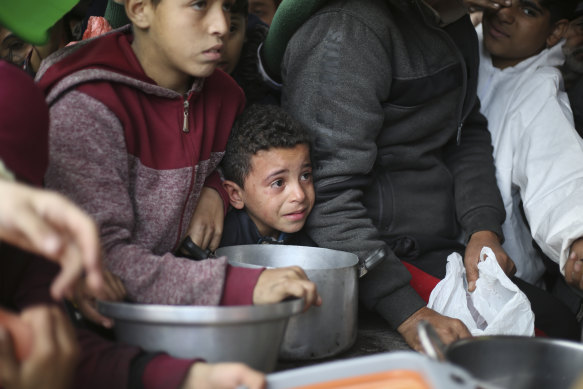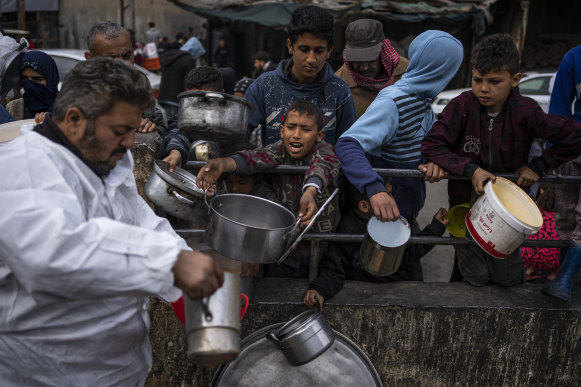This was published 1 year ago
Experts say Gaza is close to famine. What does that mean?
By Gaya Gupta
The aid delivery to northern Gaza Strip that ended in bloodshed last week showed the extent of Palestinians’ desperation, after dozens were killed while thousands converged on a rare convoy of aid trucks. As the number of aid deliveries into the Gaza Strip has rapidly dropped and Palestinians struggle to find food, humanitarians and United Nations officials are warning that famine is imminent in the enclave.
For aid groups and the UN, officially determining that a famine exists is a technical process that requires analysis by experts and can only be declared by government authorities and top UN officials.

Palestinians line up for free food distribution during the ongoing Israeli air and ground offensive in Khan Younis, Gaza Strip, last month.Credit: AP
So how is famine defined and what do experts say about the severity of hunger in Gaza? Here’s a closer look.
What is a famine?
Food-insecurity experts working on the Integrated Food Security Phase Classification, or IPC, an initiative controlled by UN bodies and major relief agencies, identify a famine in an area based on three conditions:
- At least 20 per cent of households face an extreme lack of food.
- At least 30 per cent of children suffer from acute malnutrition.
- At least two adults or four children for every 10,000 people die each day from starvation or disease linked to malnutrition.

Palestinians line up for food in Rafah, Gaza Strip, last month.Credit: AP
Since the IPC was developed in 2004, it has been used to identify only two famines: in Somalia in 2011 and in South Sudan in 2017. In Somalia, more than 100,000 people died before famine was officially declared.
IPC analysts expressed grave concern about food insecurity related to the civil wars in Yemen and Ethiopia, but said not enough information was available from governments to issue a formal assessment.
The classifications of famine in Somalia and South Sudan galvanised global action and spurred large donations. Aid workers and hunger experts point out that the hunger crisis in Gaza is already dire, with or without a famine classification, and aid is needed quickly.
“For me, what is important is to basically say that, look, technically we haven’t met the conditions of a famine, and frankly we don’t want to meet those conditions,” said Arif Husain, chief economist of the World Food Program. “So please help, and please help now.”
What is the situation in Gaza?
Palestinians, particularly in the north, have been fighting starvation and regularly converge on the relatively few aid trucks that enter the territory. Aid groups say people are so hungry that they are resorting to eating leaves, donkey feed and food scraps.
The first IPC report on Gaza, released in December, found that the enclave’s entire population was experiencing food insecurity at crisis or worse levels. Although the group said Gaza had not yet crossed the famine threshold, it warned that the risk of famine-level hunger would increase if the war did not stop.
A second food-security analysis is now underway, the IPC group said.
What are the complications?
The December, IPC analysis relied on publicly available data from international and local aid groups in Gaza which the group said met its methodology standards. But IPC analysts said they lacked recent data on the prevalence of acute malnutrition. Getting that data is very difficult in a war zone and poses a burden on already overwhelmed healthcare workers, they added.
The organisation’s criteria were originally designed to address weather-related famine, not crises like the one in Gaza, Husain said. But most severe hunger crises in recent history have been driven by conflict rather than climate, he noted.
And although IPC experts perform the analysis that can classify a famine, it is up to government authorities and the UN to formally declare one.
In some cases, countries have hesitated to do so. In 2022, Somalia’s president expressed reluctance to declare a famine during a severe hunger crisis brought on by a drought. And in 2021, Ethiopia blocked the declaration of famine in the Tigray region through heavy lobbying, according to a top UN official.
It is unclear exactly what authority could declare a famine in Gaza. The IPC group said the process typically involves a country’s government and its top UN official. Determining who that authority would be in Gaza was beyond the organisation’s scope, it said.
This article originally appeared in The New York Times.